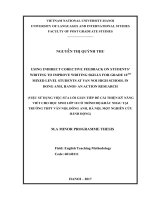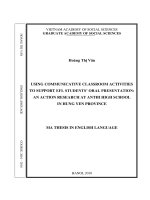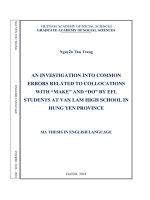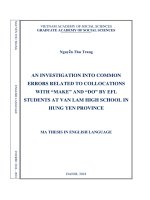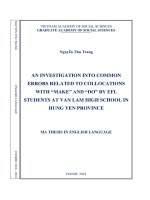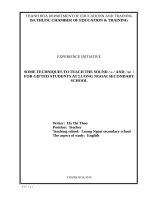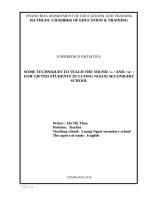An investigation into common errors related to collocations with “make” and “do” by efl students at van lam high school in hung yen province
Bạn đang xem bản rút gọn của tài liệu. Xem và tải ngay bản đầy đủ của tài liệu tại đây (898.1 KB, 91 trang )
NGUYỄN THU TRANG
VIETNAM ACADEMY OF SOCIAL SCIENCES
GRADUATE ACADEMY OF SOCIAL SCIENCES
Nguyễn Thu Trang
AN INVESTIGATION INTO COMMON
COVER PAGE 2
ENGLISH LANGUAGE
ERRORS RELATED TO COLLOCATIONS
WITH “MAKE” AND “DO” BY EFL
STUDENTS AT VAN LAM HIGH SCHOOL IN
HUNG YEN PROVINCE
MA THESIS IN ENGLISH LANGUAGE
COURSE: 2016 – 2018
HANOI, 2018
VIETNAM ACADEMY OF SOCIAL SCIENCES
GRADUATE ACADEMY OF SOCIAL SCIENCES
Nguyễn Thu Trang
AN INVESTIGATION INTO COMMON
ERRORS RELATED TO COLLOCATIONS
WITH “MAKE” AND “DO” BY EFL
STUDENTS AT VAN LAM HIGH SCHOOL IN
HUNG YEN PROVINCE
Field: English Language
Code: 8220201
Supervisor: Assoc. Prof. Dr. Phan Văn Quế
HANOI, 2018
DECLARATION BY AUTHOR
Except where reference has been made in the text, this thesis contains no
material previously published or written by another person.
I hereby state that this thesis is the result of my own research and the
substance of the thesis has not, wholly or in part, been submitted for any degrees
to any other universities or institutions
Author’s Signature
Nguyễn Thu Trang
Approved by
SUPERVISOR
Assoc. Prof. Dr. Phan Văn Quế
Date:……………………
i
ACKNOWLEDGEMENTS
I would like to express my sincere gratitude and deep appreciation to
Assoc. Prof. Dr. Phan Văn Quế, my supervisor, for his helpful and warm
encouragement as well as his insightful comments on my work from the
beginning to the end of my study. In addition, many thanks go to the teachers at
the Faculty of Foreign Languages, GASS, for their interesting lessons from
which I have benefited a lot for the accomplishment of the thesis.
The completion of this thesis would not have been possible without the
cooperation from the respondents (38 EFL students at Văn Lâm high school)
who have been willing to take part in the study. I am very grateful to all of them
for providing detailed information for the analysis of this study.
I also offer my special thanks to my colleagues and friends whose support
and encouragement help me to have this thesis accomplished.
Last but not least, I am greatly indebted to my family for their patience,
endless love, and devotion. Whatever choices I have made, they have always
stood by me and believed in me. I am immensely thankful for all the assistance
they have given me.
ii
TABLE OF CONTENTS
Page
DECLARATION BY AUTHOR…………………………………….…
I
ACKNOWLEDGEMENTS……………………………………….…...
Ii
ABSTRACT…………………………………………………........……
V
LIST OF TABLES……………………………….…………......………
Vi
LIST OF ABBREVIATIONS USED IN THE THESIS ………………
Vii
CHAPTER 1: INTRODUCTION…………………………………….
1
1.1. Rationale………………………………………………………….
1
1.2. Aims of the Study………………………………………………...
2
1.3. Research Questions……………………………………………….
2
1.4. Scope of the Study………………………………………………..
3
1.5. Significance of the Study………………………………………….
3
1.6. Research Methods…………………………………………………
3
1.7. Structure of the Study……………………………………………..
4
CHAPTER 2: LITERATURE REVIEW……………………………..
5
2.1. Previous studies……………………………………………………
5
2.2. Errors……………………………………………………………….
7
2.2.1. Definition of Error……………………………………………..
7
2.2.2. Error Analysis………………………………………………….
9
2.2.3. Problems of error classification………………………………..
10
2.2.4. Error correction…………………………………………………
11
2.2.5. Errors and collocations…………………………………………
12
2.3. Collocations………………………………………………………..
12
2.3.1. Defining Collocations………………………………………….
12
2.3.2 Types of collocations……………………………………………
15
2.3.3. Characteristics of colloctions…………………………………...
26
2.3.4. Collocations, free compounds, and idioms……………………..
28
2.3.5. Collocations with the verbs MAKE and DO…………………...
30
iii
2.4. Summary……………………………………………………………
36
CHAPTER 3: METHODOLOGY……………………………………..
37
3.1. Research Setting……………………………………………………
37
3.2. Data collection……………………………………………………...
38
3.2.1. Data collection instruments……………………………………
38
3.2.2. Data Collection Procedures…………………………………….
40
3.2.3. Data Analysis…………………………………………………...
41
3.3. Summary……………………………………………………………
42
CHAPTER 4: FINDINGS AND DISCUSSIONS……………………...
43
4.1.
Common errors ralated to “MAKE” and “DO” collocations
commited by EFL students at Van Lam high school…………………….
43
4.1.1. Word choice errors……………………………………………..
43
4.1.2. Redundant article and Missing article errors…………………...
47
4.1.3. Contextual errors……………………………………………….
50
4.2. Possible causes of “make” and “do” collocation errors…………….
53
4.2.1. Shortage of collocational knowledge...…………………………
53
4.2.2. Habit of learning individual word………………………………
54
4.2.3. Misunderstanding the meanings of “make” and “do”………….
55
4.3. Summary……………………………………………………………
58
CHAPTER 5: CONCLUSION…………………………………………
59
5.1. Recapitulation………………………………………………………
59
5.2. Concluding Remarks……………………………………………….
60
5.3. Implications………………………………………………………..
61
5.4. Limitations and Suggestions for Further Studies………………….
63
REFERENCES…………………………………………………………
I
APPENDIX 1: Test 1……….……………………………………………
V
APPENDIX 2: Test 2…………………….………………………………
VIII
APPENDIX 3: Test 3…………………………………………………….
XI
APPENDIX 4: Questionaire…………………………………..………….
XIV
iv
ABSTRACT
This study is carried out to investigate the errors related to collocations
with “make” and “do” by EFL students at Van Lam high school in Hung Yen
province. There are 38 students from class 11A9 take part in this study. A
questionnaire and tests are chosen as the data collection instruments. According
to the results of the research, when the students use the verbs “make” and “do”
in their combinations with other words, they commonly commit errors of word
choice, redundant article or missing article, word form, and misunderstading the
two verbs. In addition, the research has found out some possible causes of the
common errors involving shortage of collocational knowledge, habit of learning
individual words, and misunderstanding the meanings of “make” and “do”.
After analyzing and synthesizing the statistics, the researcher discussed and
recommended some implications along with suggestions for further research.
Last but not least, it is much hoped that the results of the study could be useful
for the development of teaching and learning English at Van Lam high school in
Hung Yen province.
v
LIST OF TABLES
Page
Table 1: Data on the results of exercise 1 - Word choice error
43
Table 2: Data on the results of exercise 2 - Word choice error
44
Table 3: Data on the results of exercise 3 - Word choice error
45
Table 4: Data on the results of exercise 4 - Word choice error
46
Table 5: Data on the results of exercise 5 - Redundant article
and Missing article errors
47
Table 6: Data on the results of exercise 6- Redundant article
and Missing article errors
48
Table 7: Data on the results of exercise 7- Redundant article
and Missing article errors
49
Table 8: Data on the results of exercise 8 - Contextual error
50
Table 9: Data on the results of exercise 9 - Contextual error
51
Table 10: Lack of collocational knowledge - Contextual error
53
Table 11: Habit of learning individual words
54
Table 12: Frequency of “make” and “do” used with collocations
55
Table 13: Difficulty of learning “make” and “do” collocations
55
Table 14: Factors making “make” and “do” collocations confusing
56
Table 15: Causes of errors ralated to “make” and “do” collocations
56
vi
LIST OF ABBREVIATIONS USED IN THE THESIS
CALD: Cambridge Advanced Learner’s Dictionary
CLT: Communicative Language Teaching
EFL: English as a Foreign Language
ESL: English as a Second Language
ETL: English Teaching and Learning
L1: The First Language
L2: The Second Language
OCD: Oxford Collocations Dictionary
vii
CHAPTER 1: INTRODUCTION
1.1. Rationale
In the process of international integration and development today,
improving students’ English communication skills, which are one of the most
important competences for 21st century global citizens, has been given
prominence in Vietnamese National Educational Curriculum. Thanks to the
innovation in English textbooks and National exam policy, Communicative
Language Teaching (CLT) methods have been widely applied in Vietnamese
high schools all over the country in recent years. In order to meet the
requirement of the curriculum standards and achieve native-like competence in
English, learners must concentrate on enhancing vocabulary, especially
collocations.
A collocation is simply any combination of words that are commonly
combined to create a phrase in the English language. In fact, such phrases are so
common in the language that using a synonym for one of the words in the phrase
can lead to it sounding unnatural to a native speaker. For example, make an
error and fatal error are two commonly used word combinations that qualify as
collocations. The verb make and the adjective fatal recurrently co-occur with the
noun error. In addition, it has been believed that knowing a word includes
knowing its collocations (Lewis, 2000; Nation, 1990/ 2001). Many scholars
have maintained that collocational knowledge is one important factor that
contributes to the differences between native speakers and foreign language
learners (Aston, 1995; Fillmore, 1979; Pawley & Syder, 1983). Particularly,
failure to use collocations accurately for EFL learners is a major indicator of
foreignness (McArthur, 1992; McCarthy, 1990; Nattinger, 1980). The strongest
position held so far is that collocational competence is an indispensable
component in the process of second/ foreign language acquisition (Lewis, 1997/
2000; Nattinger & DeCarrico, 1992; Richards & Rogers, 2001). Accordingly,
learners’ collocational knowledge is the essense of language knowledge.
1
Despite the benefits and usefulness of collocations for learners, learning
how to produce them is actually quite challenging. Many students, especially
those who live in rural areas, do not get the high results in the National exams
and can use poor English after school. They often make collocational errors
when they use spoken and written English. As a teacher of English at Van Lam
High school in Hung yen province, the researcher feels rather concerned about
students’ ability to use collocations in English. However, the knowledge of
collocations is a vast area in linguistics so this study only focuses on the
common errors related to collocations with the verbs “make” and “do” made by
EFL students at Van Lam high school. I choose to do the research for two
reasons. Firstly, many English learners feel confused and make mistakes when
they use the two verbs collocating with other words although “make” and “do”
are among the most common verbs in English. Secondly, the various ways of
interpreting “make” and “do” collocations from English to Vietnamese may
create difficulties for language students as the meanings of these collocational
phrases depend on the elements after the two verbs.
1.2. Aims of the Study
The study aims at:
- Helping
EFL students
gain
an
insight
into
MAKE
and
DO
collocations.
- Examining the influenced factors to possible errors made by the students.
- Improving my own teaching of English at Van Lam high school.
1.3. Research Questions
To fully achieve the above aims, the study answers the following questions:
- What are the common errors related to MAKE and DO collocations
committed by EFL students at Van Lam high school?
2
- What are the causes of students’ errors related to MAKE and DO
collocations?
1.4. Scope of the Study
This study is confined to the investigation into a very small aspect of
vocabulary issue - the common errors related to collocations with the two verbs
“make” and “do” in English. The two verbs “make” and “do” are frequently
used, yet they are among the most confusing words for English learners . In
other words, it is easy to misunderstand and misuse the two verbs. Furthermore,
they can be in many different collocations with different meanings. Both “make”
and “do” can collocate with a noun, a preposition, an adjective or an adverb, etc.
Within the framework of an M.A. thesis, the author has no ambition to cover all
the kinds of collocation with the two verbs, only errors related to the uses of
MAKE and DO collocations in the form of “verb + noun” pattern were taken
into consideration.
1.5. Significance of the Study
It is much to the author’s expectation that the research results will help
students gain a more insightful look into English MAKE and DO collocations.
And, on account of this, well-formed utterances containing MAKE and DO
collocations might be produced. And, this constitutes the practical value of the
research.
1.6. Research Methods
This study is qualitatively and quantitatively conducted with the
descriptive, analytical, synthetical, and inductive methods. A survey is
conducted to study the common errors related to “make” and “do” collocations.
The study is caried out with the hope to help learners avoid making
mistakes when doing exercises and using the verbs “make - do” and their
3
combinations with other words. In addition, it is to investigate the usage of
collocations with “make - do” so that the EFL students at Van Lam high school
can get better knowledge of collocations with “make - do”
1.7. Structure of the Study
The thesis consists of five main parts:
Chapter 1 - Introduction: The first chapter gives reasons for choosing the
thesis, scope and aims of the study as well as the research method and the
structure of the study.
Chapter 2 - Literature Review: This chapter both reviews some previous
studies related to the research area of the thesis and provides theoretical
background to the concerning matters.
Chapter 3 - Methodology: In the third chapter, the methodology of the
thesis including research-governing principles and research methods are
introduced.
Chapter 4 - Findings and Discussion: This part analyzes data collected
from
the students’ tests. Additionally, some significant findings of the study are
written up and discussed.
Chapter 5 - Conclusion: The last chapter concludes the main issues which
dealt with in the previous parts. Accordingly, some concluding remarks a
redrawn out.
4
CHAPTER 2: LITERATURE REVIEW
2.1. Previous studies
There are a large number of research studies, focusing on collocations
with “MAKE” and “DO” that were conducted by both foreign and Vietnamese
researchers. From the experiences and what the researcher has searched, few
important studies particularly concentrate on errors
related to collocations
committed by EFL students. Following are some related articles and studies:
Firstly, Martynska (2004) presented the level of collocational competence
among intermediate learners of the English language in the paper entitled “Do
English language learners know collocations?”. The researcher conducted the
study of English collocation competencies among intermediate high school
Polish students. To collect data, the researcher used different types of tests,
for example, matching, a completion, circling the correct option, and identifying
and correcting errors in underlined parts of sentences. The findings showed that
the students performed poorly on all tasks. One important result was that their
collocation competence did not depend on the length of time of learning English
because the student studying English for a short time performed better on the
English tests than those who studied English for longer time. Moreover, in
comparison between two types of task, it was found that some students got
higher scores on the multiple-choice tasks but lower scores on the completion
tasks. This confirmed that the production of collocation among the students
was much lower than their receptive skills. Therefore, more attention to
collocations when teaching English should be paid in the teaching and learning
process.
Secondly, the research “The acquisition of basic collocations by Japanese
learners of English” by Koyo Taeko (2005) identifies basic collocations for
Japanese learners of English and examines the mechanism of collocational
knowledge of Japanese learners of English. The findings were based on two
types of analyses; a corpus-based analysis to identify basic collocations and
5
an empirical analysis to examine how Japanese learners develop knowledge
of collocation. The researcher came to such a conclusion that there was a
significant positive relationship between learners’ general knowledge of
vocabulary and their knowledge of collocations. The knowledge of the learners’
on receptive collocation tasks was better than their productive ones, and the
learner had difficulty with some collocation categories, such as adjective-noun
collocations in comparison with others.
Thirdly in “The acquisition of collocation by Turkish EFL learners”,
Elyildirm (1998) examined the comprehension and production of the target
collocations of the first language (L1) Turkish learners of English. By using
three collocation tests: correct or incorrect test, translation test and a gap-filling
test including two collocation categories, i.e. verb-noun collocations and
adjective-noun collocations. The researcher found that the negative influence
of L1 on the production of collocations was quite clear. In fact, participants
tended to generalize unfamiliar combinations in reference to the familiar ones
that
learners frequently encountered in the textbook. Learners also have a
tendency to incorrectly overgeneralize their L1 collocational knowledge with
unknown collocations, which resulted in L1negative transfer. The researcher
also confirmed that acquiring collocations that have L1 equivalent was easier
than that of acquiring collocations that have no L1 equivalents. Additionally,
comparing two types of test it was observed that the participants performed
better on the adjective-noun collocation test than verb-noun-collocation test,
which they found to be more
difficult. The researcher recommended
the
teaching of common collocations and suggested learners to spend much time
reading and listening to improve their knowledge of collocations instead of
avoiding them.
In Vietnam, Phạm Thị Ngà (2012) had a similar study for her unpublished
M.A thesis. The study was directedly relevant to teaching and learning
collocations at university. The survey was conducted at Thai Nguyen University
of Economics and Business Administration. The thesis studied students’ errors
6
in using collocations with the verbs “do” and “make” and showed the difficulties
in recognizing suitable words which can collocate with each verbs. Additionally
it gave some suggestions to improve quality of teaching and learning English at
university in Vietnam.
Finally, in Hung Yen province and Van Lam district where the researcher
has been working for more than 18 years, it has not been conducted any studies
or articles related to the subject of improving English vocabulary, especially
knowledge of collocations, for high school students. Therefore, this thesis
hopefully will make a small contribution to teaching and learning collocations at
a high school, so that students can get better results in their exams and enhance
their ability in communication.
2.2. Errors
2.2.1. Definition of Error
Making errors is the most natural thing in the world and it is evidently
attached to the human beings. But there are different definitions of the word
“error”. For the errors in the foreign language learning, the most common
definition is "Errors are deviations from the standard or violations of the
standard", but it can also raise further questions. Which standard applies in a
pluricentric language as the standard for the foreign language teaching? An
attempt to formulate by definition the criteria of the linguistic correctness,
appropriateness, comprehensibility, connection to the lessons and learneroriented ability can be found in Kleppin (1998):
a) "An error is a deviation from the language system.
b) An error is a deviation from the existing linguistic standard.
c) An error is a violation of the way a person within a speech community speaks
and acts.
d) An error is what a communication partner does not understand.
e) An error is what a native speaker does not understand.
f) An error is something contrary to rules in textbooks and to grammars.
7
g) An error is what a teacher refers to as an error.
h) An error is what a native speaker in a particular situation would not say or
do.
i) An error is something contrary to the norm in the head of the teacher.
j) Errors are relative. What is considered to be an error in a learning group in a
particular teaching phase, is tolerated in another learning group in another
phase." (Kleppin, 1998, p19)
The term "error" is used to refer to a systematic deviation from a selected
norm or set of norms. According to Lennon (1991) an error is "a linguistic form
or combination of forms which in the same context and under similar conditions
of production would, in all likelihood, not be produced by the speakers 'native
speaker's counterparts". On one hand, it was considered to be a sign of
inadequacy of the teaching techniques, something negative which must be
avoided, and on the other hand it was seen as a natural result of the fact that
since by nature we can't avoid making errors, we should accept the reality and
try to deal with them.
The error-as-progress conception is based on the Chomsky's idea that a
child generates language through innate universal structures. So, using this
symbolic code, one can have access to different pieces of knowledge not as
something mechanically learned but as mentally constructed through try and
error. The idea is now that the second language learners form hypotheses about
the rules to be formed in the target language and then test them out against input
data and modify them accordingly.
There is an approach which concerns error as being the result of socialcognitive interaction. This means that the error implicitly carries a social norm
as well as cognitive process. The error also carries a social and cultural
component which makes it different in different societies.
8
2.2.2. Error Analysis
The growing interest of investigating errors types led apparently to the
rise of error analysis. Error analysis can be defined as an examination of those
errors committed by learners in both spoken and written medium (Mohideen,
1996). It is worth noting that error analysis gives a picture of the type of
difficulty learners are experiencing (Norrish, 1994, p80). Richards (1971)
justifies the importance of error analysis as it functions as input to theoretical
discussion. In the phase of evaluation, error analysis offers appropriate feedback
to the design of remedial curricula. Similarly, Mohideen (1996) indicates that
error analysis is useful in ESL/EFL because it reveals the problematic areas to
language teachers, syllabus designers and textbook writers. In this regard, due to
the fact that foreign language learners lack the automation of collocations which
may result in errors that hinder their learning English, the analysis of collocation
errors is strongly believed to be adopted in this study as an effective way to help
English language students overcome difficulties. Various approaches to error
analysis are formed basically for investigating errors. In 1974, Corder (pp. 158171) identified a representative model for error analysis. His model can be
summarized as followed. The initial step requires the selection of a corpus of
language followed by an identification of errors. The errors are then classified.
The next step, after giving a grammatical analysis of each error, it is demanded
to give an explanation of different types of errors. Gass and Selinker (1994, p.
67) add additional two steps: analyzing sources of error, and offering remedy for
errors. In another attempt for analyzing errors, Norrish (1994, p. 81) states that
there are fundamentally two main approaches to error analysis. The first one is
to set up categories of errors, based on a set of preconceptions about the learners'
most common problems. This approach has an advantage of being easier and
quicker to carry out because errors are indicated on a list of categories.
However, the drawback of this approach is that the issue is prejudged, since
errors can be sorted out only in terms of predetermined error types. The second
approach is to group the errors as they are collected in particular areas. Such
9
approach has the advantage of allowing the errors themselves to determine the
categories chosen. By a process of sorting and re-sorting errors, the categories
will eventually define themselves. From the standpoint of the researcher, it can
be stated that Corder's approach (1974, pp. 158- 171) to error analysis matches
with the second approach offered by Norrish (1983, p. 80) because both
approaches basically tend to identify errors types and classify them from the
corpus itself.
2.2.3. Problems of error classification
Rein (1983:99) defines the error analysis as follows: “Error analysis is
concerned with the registration (= error statistics) and the genetic analysis (=
error analysis) of systematic errors occurring at different stages of language
learning with the practical intention to develop objective standards of judgment
(= error evaluation) or didactic measures in order to reduce or eliminate such
errors (error = therapy)."
Errors are classified according to the linguistic plains where they occur.
According to the different linguistic plains there can be distinguished phonetic /
phonological, lexical / semantic, morphological / syntactic and pragmatic errors.
Although errors can not always be clearly assigned to one or the other level, the
classification of the errors can be well handled according to the different
linguistic levels. The other criterion in the classification of the errors is the cause
of the error. While determining the reasons that could cause the error, there can
be distinguished the intra- and the inter-linguistic causes, depending on whether
the error was caused due to the influence of the mother tongue or due to the
target languages. Interference errors are caused by the influence of the mother
tongue. Overgeneralizations occur because of the influence of the target
language. Errors are caused also by compensation strategies because learners
tend to describe unknown words. Very often the learners have different
hypotheses about the nature of the foreign language and therefore they commit
really creative errors.
10
Sometime grammatically and lexically correct sentences can be
considered as errors if they are socio-culturally inappropriate.
Likewise, a correct statement can be considered as an error when the type
of text used, is not appropriate.
The lessons and the teacher can also be the cause of the error, if the
explanations cause errors. A typical example of teaching generates errors is the
application of the self-correction of the past tenses in German. The errors signal
the lack of the knowledge on the use of the tenses. Another different distribution
of the errors in performance errors and competence errors arises from the level
of the knowledge of the language learner.
Competence errors are understood as errors that the learner usually
commits because he lacks on knowledge of the respective grammatical rules.
Performance errors are caused by fatigue or lack of concentration, possibly stage
fright. These are errors, that the learner can identify and correct itself.
2.2.4. Error correction
Behind every error correction is the desire that learners make fewer
mistakes. To correct written errors is relatively easy because while the teacher is
correcting, he has time to think about how and what he should correct. During
the oral correction, the procedure is much more complicated. Factors that dictate
the error correction:
- Type of the error depending on the linguistic level,
- Phase of the lesson - in the communicative phase of the lesson the correction is
done in a different way as in the practice phase,
- Beginners are corrected in a different way as advanced learners are,
- During the phase of communication, it makes more sense, to correct by the end
of the sentence than to interrupt the flow of the speech of the learner,
- Human factors: there are learners who have a correction demand and others
who suffer from the correction. There are teachers who use different correction
methods and teachers who always use the same method of correction. Another
aspect of the error correction is the question whether the teacher should prefer
11
explicit or implicit correction methods. Explicit correction means that the
teacher draws the attention of the learner to the error through open discussions.
Implicit error correction means that the teacher only repeats correctly the wrong
expression of the learner.
2.2.5. Errors and collocations
As the researcher's concern is investigating collocation errors, it is
essential not to neglect what linguists contribute to the area of errors. Errors
have become a field of interest not only for teachers but for linguists and
psychologists as well (Gass and Selinker, 1994, pp. 66-67). Dulay and Burt
(1974, pp. 95) state that errors have played an important role in the study of
language acquisition in general and in examining second and foreign language
acquisition in particular. In the applied linguistics community, it was Corder
(1967, pp. 19-27) who first advocated the importance of errors in language
learning process. From the errors that learners make, one can determine their
level of mastery of the language system (Corder, 1967, p. 25). He observed that
the learners' errors are indicative both of the state of the learners' knowledge and
the ways in which a second language is learned. It can be said that linguists pay
considerable attention to language errors in a broad sense. Thus, the researcher
can narrow down this general view of exploring errors into investigating
collocation errors in particular.
2.3. Collocations
2.3.1. Defining Collocations
Forming a precise definition of collocation is not easy, though there
is a vast literature on this subject because there are both conflicting
definitions and conflicting terminologies: “Regrettably, collocation is a term
which is used and understood in many different ways” (Bahns, 1993, p57).
There have been a lot of ideas when considering the term “collocation”.
Different linguists have their own ways to define what a collocation is. A
12
collocation is mainly considered as a lexical relationship between words. It is
assumed that words receive their meanings from words they occur with. One of
the works should be noticed is Second Interim Report on English Collocation
by H.E.Palmer (1933) who is considered the first linguist to use the term
Collocation in the present-day sense. According to Palmer (1933), collocation is
defined as word combinations containing one or more words having meanings
only in that collocation. According to Halliday (1966, p. 152), collocation is
one of the main components and central part in his lexico-grammatical system.
He defines collocation as syntagmatic relation of words which is linear cooccurrence together with some measure of significant proximity. It is a sequence
of words or terms that co-occur more often than would be expected by chance.
In phraseology, collocation is a sub-type of phraseme. An example of a
phraseological collocation, given by Michael Halliday, is the expression “strong
tea”. Although the expression “powerful tea” could be roughly conveyed the
same meaning, it is considered incorrect by English speakers. Or the
corresponding expression for computer, “powerful computers” is widely used
rather than “strong computers”.
In his study, Greenbaum approaches collocation as an integration between
lexis and grammar which are different in lexical and syntactic patterning but
interrelated. “Collocation meaning is changed according to different syntactic
patterning” (Greenbaum, 1960, p. 12). The term “collocation” introduced by
Firth (1957) is often defined as a characteristic word combination whose lexical
constituents developed an
idiomatic relation based on their frequent co-
occurrence. According to Cruse (1984) a collocation, along with a lexeme and
an idiom, is a kind of lexical item and is “sequences of lexical which habitually
co-occur, but which are nonetheless fully transparent in the sense that each
lexical constituent is also a semantic constituent” (Cruse, 1986, p. 40). Although
there are a variety of views on the concept of collocation, variously defining it
as a lexical, grammatical or research phenomenon, all contain a focus on the cooccurrence of words.
13
According to Micheal Mc Carthy and Felicity O’Dell (2005), “a
collocation is a pair or group of words that are often used together. These
combinations sound natural to native speakers, but students of English have to
make a special effort to learn them because they are often difficult to guess.
Some combinations just sound 'wrong to native speakers of English. For
example, the adjective fast collocates with cars, but not with a glance” (p. 4)
Cambridge Advanced Learners’ Dictionary (CALD, 2005) defines
collocation as “a word or phrase which is frequently used with another word or
phrase, in a way that sounds correct to people who have spoken the language all
their lives, but might not be expected from the meaning. In the phrase 'a hard
frost', 'hard' is a collocation of 'frost' and 'strong' would not sound natural ‟or„
the combination of words formed when two or more words are frequently used
together in a way that sounds correct but difficult to guess.”
Here are some different definitions given by Oxford Collocations
Dictionary (2009) (OCD):
-The habitual juxtaposition of a particular word with another word or
words with frequency greater than chance
- A pair or group of words that are juxtaposed in such a way - the action
of placing things side by side or in position”
- A grouping of words in a sentence
- Juxtaposition: the act of positioning close together (or side by side); "it
is the result of the juxtaposition of contrasting colors"
- (Collocate) have a strong tendency to occur side by side; "The words
'new' and 'world' collocate"
- (Collocate) group or chunk together in a certain order or place side by
side
- Within the area of corpus linguistics, collocation defines a sequence
of words or terms that co-occur more often than would be expected by
chance.
14
- Collocation is a procedure used in remote sensing to match
measurements from two or more different instruments.
- The grouping or juxtaposition of things especially words or sounds
- The tendency for words to occur regularly with others: sit/chair,
house/garage.
- The phenomenon of words/lexical items tending to co-occur in close
proximity to one another in spoken/written discourse (i.e. habitual or
greater than chance co-selection of words).
- The likelihood that a particular word will occur in the neighborhood of
another word.
- The action of setting in place,especially arranging in relation to others.
- Group of words associated together as an expression in the lexicon. Our
class has decided "in this particular case" is a collocation in McGowan's
idiolect.
- A collocation consists of two or more words that are commonly
associated in a particular language, such as “read about” or “white
lies”. A word may take on a specific meaning when collocated with
certain other words.
- Refers to how words occur together regularly and in a restricted way e.g. blond hair, lean meat, etc.
Although there are different ways to define what collocation is, these
definitions share a common view that a collocation is a word or phrase used
frequently in a combination but it is not easy for learners to guess.
2.3.2 Types of collocations
First of all, it is necessary to distinguish between grammatical and lexical
collocation. This partr is going to deal with both types of collocations, initially
with grammatical ones, later with lexical ones ones. The question of strong and
weak collocations will also be discussed.
Grammatical Collocations
15
“Grammatical collocations consist of a noun, or an adjective or a verb,
plus a particle (a preposition, an adverb or a grammatical structure such as an
infinitive a gerund or clause)” (Bahns, 1993, p. 57). The followings are the
examples: at night, extend to, good at, fall for, to be afraid that. These
examples are grammatical collocations which are lexicalized as single
units whose meanings are formulaic and whose co-occurence are highly
likely. They are sometimes idiomatic, because their meanings do not reflect
the meanings of the elements, such as run out of (to reach an end of stock,
supplies) or put up with ( tolerate). However, there are similar grammatical
combinations which do not have such a “strong sense of belonging together”.
According to Kennedy (1990, p. 224), these prepositional phrases “ from the
outside, inside the cupboard” are considered as free combinations.
According to Benson and Ilson (1986) in their introduction to their The
BBI Combinatory Dictionary of English grammatical collocations fall into
the following combinations: noun + preposition, noun + to-infinitive, noun +
that-clause, preposition + noun, adjective + preposition, predicate adjective
+ to-infinitive, adjective + that-clause, and the English 19 verb patterns.
noun + preposition combinations
Not all noun + preposition combinations can be considered as
collocations due the highly predictable meaning of some prepositions,
such as of and by. So, noun + of / by combinations are considered free
combinations. The following phrases are examples of noun + preposition
collocations: blockade against, apathy towards.
noun + to + infinitive
There are five syntactic patterns in which noun + to + infitive construction
is most frequently encountered:
a. It was a pleasure ( a problem, a struggle) to do it
b. They had the foresight (instructions, an obligation, a permission) to do
it
c. They felt a compulsion (an impulse, a need) to do it
16


